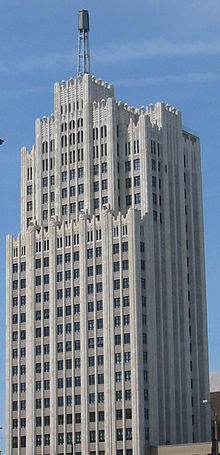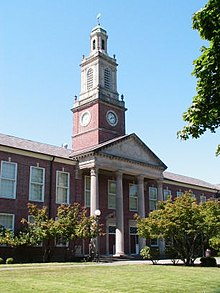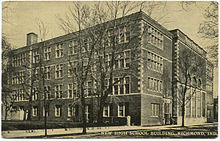William B. Ittner

William Butts Ittner (September 4, 1864 – 1936) was an architect in St. Louis, Missouri. He designed many school buildings in Missouri and other areas, was president of the St. Louis Chapter of the American Institute of Architects from 1893–95,[1] was awarded an honorary degree by the University of Missouri in 1930, served as president of the Architectural League of America during 1903–04, and at the time of his death was president of the St. Louis Plaza Commission, a fellow and life member of the American Institute of Architects, and a thirty-third degree Mason.[2] He was described as the most influential man in school architecture in the United States[3] and has a star on the St. Louis Walk of Fame.[4] He was appointed St. Louis School Board commissioner in 1897 and is said to have designed open buildings that featured "natural lighting, inviting exteriors, and classrooms tailored to specific needs." [5]
Background
His parents were Anthony F. and Mary Butts Ittner.[1] His father worked at a lead plant and then as a bricklayer before founding Ittner Bros. with his brother Conrad in 1859.[1] William Ittner's father (later a U.S. Congressman) helped establish the trade school from which his son graduated in 1884 "with the first class granted diplomas by Washington University's Manual Training School."[1] He also graduated with a degree in architecture from Cornell University, traveled in Europe and married Lottie Crane Allen in St. Louis. He worked in the office of Eames & Young between 1889 and 1891, then practiced alone "before entering brief partnerships, first with William Foster and then with T. C. Link and Alfred Rosenheim."[1]
He was elected to the new office of Commissioner of School Buildings for the Board of Education in 1897 and remained in the position until he resigned in 1910.[1] He continued as "consulting architect" to the Board until October 1914.[1] His first school design was Eliot School (1898–99) and his last was Bryan Mullanphy (1914–15).[1]


He is credited with the design of over 430 schools nationwide and has over 35 buildings on the National Register of Historic Places.[3][5] E shaped schools were said to be his trademark.[3]
Projects
Residences
- 6034 West Cabanne Place, St. Louis, Missouri (1891)[1]
- 2137–39 California Avenue, St. Louis, Missouri (1893)[1]
- 3439 Longfellow, St. Louis, Missouri (1893) [1]
- 3013 Hawthorne, St. Louis, Missouri (1894) [1]
- 3435 Hawthorne, St. Louis, Missouri (1895)[1]
Schools


- Board of Education Building, St. Louis, Missouri (1893) (NRHP)
- Arlington School, St. Louis, Missouri (1898) (NRHP)
- Jackson School, St. Louis, Missouri (1898) (NRHP)
- Rock Spring School, St. Louis, Missouri (1898) (NRHP)
- Simmons Colored School, St. Louis, Missouri (1898) (NRHP)
- Eugene Field School, St. Louis, Missouri (1900) (NRHP)
- Wyman School, St. Louis, Missouri (1900) (NRHP)[5]
- Grant School, St. Louis, Missouri (1901) (NRHP)
- Ralph Waldo Emerson School, St. Louis, Missouri (1901) (NRHP)
- Horace Mann School, St. Louis, Missouri (1901) (NRHP)
- Eliot School, St. Louis, Missouri (1901) (NRHP)
- Harris Teachers College, St. Louis, Missouri (1906) (NRHP)
- Hempstead School, St. Louis, Missouri (1906) (NRHP)
- Greenville High School, Greenville, Ohio
- Sumner High School, St. Louis, Missouri (1908)[5]
- Ralph Waldo Emerson School, Gary, Indiana (1908) (NRHP)
- Carr School, St. Louis, Missouri (1908) (NRHP)
- Soldan High School, St. Louis, Missouri (1909)
- Wichita High School, Wichita, Kansas (1910) (NRHP)
- Central High School, South Bend, Indiana (1911) (NRHP)
- Delaney School, St. Louis, Missouri (1911) (NRHP)
- Shelbyville High School, Shelbyville, Indiana (1911) (NRHP)
- Hume-Fogg High School, Nashville, Tennessee (1912) (NRHP)
- Grover Cleveland High School, St. Louis, Missouri (1913)
- Thomas C. Miller Public School, Fairmont, West Virginia (1914) (NRHP)
- McClain High School, Greenfield, Ohio (1915)[3]
- W. H. Adamson High School, Dallas, Texas (1915)
- The Wilson School, St Louis, Missouri (1916)
- Forest Avenue High School, Dallas, Texas (1916) (NRHP)
- Francis L. Cardozo Senior High School, Washington, D.C. (1916) (NRHP)
- Marshall School, St. Louis, Missouri (1918) (NRHP)
- Former Niagara Falls High School, Niagara Falls, New York (1921) (NRHP)
- Franklin School, St. Louis, Missouri (1923) (NRHP)
- Normandy High School, Normandy, Missouri (1923)
- Central High School, Columbus, Ohio (1924) [3]
- St. Petersburg High School, St. Petersburg, Florida (1926) (NRHP)
- Robert Alexander Long High School, Longview, Washington (1927) (NRHP)
- Dunbar School, Fairmont, West Virginia (1928) (NRHP)
- Fairmont Senior High School, Fairmont, West Virginia (1928) (NRHP)
- Ramsey High School, Birmingham, Alabama (1930)
- Lincoln School, Springfield, Missouri (1930)
- University City High School, University City, Missouri (1930) (NRHP)
- Phelps School, Springfield, Missouri (1931[6])
- Morton High School, Richmond, Indiana (1939)
- Park City Junior High School, Knoxville, Tennessee (NRHP)
- Greenfield Educational Complex, Greenfield, Ohio[3]
Other buildings
- Principia Page-Park YMCA Gymnasium, St. Louis, Missouri (1910) (NRHP)
- Missouri Athletic Club, St. Louis, Missouri (1916) (NRHP)[1]
- Scottish Rite Cathedral, St. Louis, Missouri (1921)[5]
- St. Louis Colored Orphans Home, St. Louis, Missouri (1922) (NRHP)
- Missouri State Teachers Association Building, Columbia, Missouri (1927) (NRHP)
- Continental Life Building, St. Louis, Missouri (1929)[5]
External links
References
- ^ a b c d e f g h i j k l m n Carolyn Hewes Toft William B. Ittner, FAIA (1864–1936) Landmarks Association of St. Louis
- ^ William B. Ittner at archINFORM
- ^ a b c d e f Educational architecture in Ohio: from one-room schools and Carnegie ... By Virginia Evans McCormick page 107
- ^ St. Louis Walk of Fame. "St. Louis Walk of Fame Inductees". stlouiswalkoffame.org. Retrieved 25 April 2013.
- ^ a b c d e f [1] 09-04-1864 6661 Delmar inducted 10-04-2008 St Louis Walk of Fame
- ^ http://thelibrary.org/lochist/postcards/phelps_school.cfm
